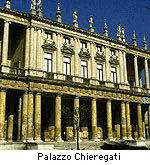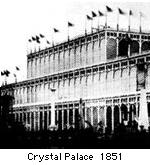|
Palladio, Andrea 1518-1580 Italian architect famous for his elegant classical style.
One of the most influential architects in European history Palladio was born in Padua. Originally named Andrea di Pietro dalla Gondola, he received the name Palladio when he joined the academy of the Italian poet Giangiorgio Trissino, who over-saw Palladio's architectural studies. Palladio learned the principles of Vitruvius, the classical Roman architect whose treatise had been rediscovered in the prior century, and of the Renaissance commentator - Alberti. In and near Vicenza he designed many residences and public buildings. The best known of these are the Barbarano, Chieregati, Tiene, Porto, and Valmarana palaces and the Villa Capri, or Villa Rotunda. From about 1560 to 1580 he built several churches in Venice, notably San Francesco della Vigna, San Giorgio Maggiore, and Il Redentore. His last great work was the Teatro Olimpico in Vicenza. His influence was ensured by his revolutionary treatise 'The Four Books of Architecture' .
Paxton started his career as a gardener for the Duke of Devonshire. He designed large greenhouses for the Duke at Chatsworth, and these were used as the basis for his successful design of the Great Exhibition building in glass and steel, the Crystal Palace, which used the idea of a simple repeating motif to achieve an economical yet harmonious building. He continued to work on landscape gardening and laying out of public parks, but also designed various country houses and other domestic buildings.
Piranesi created more than 2000 prints of real and imaginary buildings and statues. His renderings of ancient Roman monuments, included both accurate portrayals of existing ruins and imaginary reconstructions of ancient buildings. One of Piranesi's most renowned collections is his Carceri d'Invenzione (Imaginary Prisons), in which he transformed Roman ruins into fantastic dungeons dominated by immense, gloomy arcades, staircases rising to incredible heights, and bizarre galleries leading nowhere. These engravings became an important influence on 19th-century romanticism and also played a role in the development of 20th-century surrealism.
www link :
Pissarro was born in Saint Thomas, Virgin Islands. He moved to Paris in 1855 and studied there with the French landscape artist Jean Baptiste Camille Corot. He later became associated with the Barbizon school. Afterwards, he came under the influence of Claude Monet and other impressionists. During the Franco-German War he lived in England, where he made a study of the landscapes of Joseph Turner. On his return to France he settled in Normandy. For a while, in the 1880's, he experimented with pointillism, the neoimpressionist style of painting with dots of color, but later returned to the impressionist school.
www link :
|



